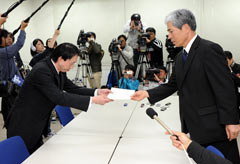Okinawan governor submits opinion on the Futenma relocation plan, calling it “impossible”

At the Okinawa Defense Bureau at 3:30pm on February 20, Masayuki Yasutomi, head of the Okinawa Prefectural Government Environmental Policy Division, submitted the Okinawan governor's written statement of opinion on the environmental impact assessment report.
February 21, 2012 Ryukyu Shimpo
In the afternoon of February 20, in keeping with the regulations governing the environmental impact assessment report (EIA) submitted by the Okinawa Defense Bureau to the Okinawa Prefectural Government (OPG) last December on the plan to construct an alternative facility for the relocation of Futenma Air Station to Henoko, Nago, Governor of Okinawa Hirokazu Nakaima submitted a written statement of opinion on the EIA to the Okinawa Defense Bureau.
In the statement, Nakaima firmly pointed out that the current plan to construct an alternative facility at Henoko poses serious problems for the environment. The statement concluded that it would be impossible for the environmental protection policy and other measures proposed by the government in the EIA to properly conserve the living environment and natural environment around the area in question. In the preamble, Nakaima reiterated the position of the OPG, which has repeatedly demanded the relocation of Futenma Air Station out of Okinawa and an early return of the land used by the base.
With regard to the planned relocation to Henoko, Nakaima emphasized the position of the OPG, stating, “It will be impossible to implement a relocation plan that will not obtain local consent, and moving the facilities at Futenma to some other part of Japan is a logical and swift solution.”
Nakaima also pointed out that there are 175 problems in the government’s assessment report in 25 areas such as the impact on the habitat of the dugong, an endangered marine mammal, and the planned deployment to Futenma beyond this summer of the MV-22 Osprey vertical takeoff and landing aircraft.
The EIA includes the Osprey among the aircraft scheduled to operate out of the alternative facility. Changes have subsequently been made in the flight path for these aircraft, which impacts upon all of the noise levels for surrounding residential areas. Nakaima expressed strong dissatisfaction with the EIA, stating, “I am greatly concerned that important environmental information in the EIA being changed at the final stage of the assessment process could create a precedent in the system.”
In the press conference, Hiroshi Shimoji, the head of the Okinawa Prefectural Government Department of Environmental and Community Affairs, claimed that under the current plan it would be impossible to protect the environment around the envisaged relocation site, saying, “Although the central government has said that there are no problems in terms of environmental conservation, without scientific data this assessment report is hard to accept.”
The OPG is scheduled to submit its opinion on the reclamation aspect of the relocation project to the Okinawa Defense Bureau by March 27.
The central government can revise its assessment report based on the governor’s opinion, but drastic changes could have a major impact on the current relocation plan. The central government makes amendments, which will be officially announced and inspected, and with that, the evaluation assessment process is complete.
It was pointed out that it is possible that in June the central government will apply to the OPG for approval of the land reclamation work, but Foreign Minister Koichiro Gemba has indicated that the government’s request for permission may be put back to this autumn or later.
(English translation by T&CT, Mark Ealey)

Go To Video
Previous Article:Students from Dalian on Okinawan culture experience tour
Next Article:Nine Chinese couples have weddings in Okinawa ― Internet-based advertising of resort weddings
[Similar Articles]
- Okinawa Prefectural Board rejects Futenma relocation plan after reviewing Henoko environmental impact report
- Okinawa governor rejects environmental impact assessment report
- Defense Minister intends to submit Henoko environmental impact report before the end of the year
- Rift between Okinawa and Tokyo-Washington DC further expanded by Japan-U.S. defense ministers’ meeting
- Defense Minister says Henoko environmental impact report will be submitted to Okinawa Governor and Nago Mayor before the end of the year
 Webcam(Kokusai Street)
Webcam(Kokusai Street)


